Stop Hitting Behind Golf Ball Once and for All
Let’s Put an End to This: Finally Learn How to Stop Hitting Behind the Golf Ball So You Can Start Loving the Game Again.
I cannot tell you how many students show up at my lesson tee desperate to learn how to stop hitting behind the golf ball.
And man, I get it. Hitting a solid, centered shot is one of the most enjoyable parts of the whole game. Those topped shots, on the other hand? Those chili dips? Miserable. Especially when you can’t seem to fix the problem.
Here’s the good news:
Like most fixes in golf, learning how to stop hitting behind the golf ball isn’t hard. In fact, there’s a decent chance you can start getting more solid, consistent contact tomorrow.
You’re about to learn three reasons why you might be having these problems. One of the reasons might even be something you’ve been taught to do.
Most importantly, you’ll discover how to fix these issues, improve your ball striking, and play your best round in years.
Let’s get into it.
Fix #1: Check Your Weight Shift
If you’re a regular here at USGolfTV, you know I’m a huge proponent of shifting your body weight to generate swing speed. By transferring your weight back and forth between your feet throughout your swing, you build power without the need for painful twisting.
As it turns out, this pressure shift is also key for achieving solid contact. That’s because the position of your body weight influences where the low point of your swing lands.
It’s like this:
When you get set up, you want to put a little more of your body weight in your lead foot than in your trail foot. Think of it as a 60/40 split.
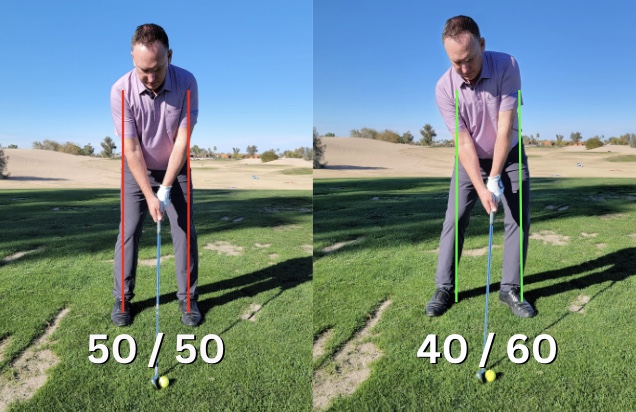
As you swing back, you shift that weight into your trail foot. Then as you swing down and through, you shift nearly all your weight back into the lead foot.
Some golfers fall into the habit of keeping their weight on the trail foot as they swing down towards the golf ball. The problem?
When you keep your weight back, you move the low point back, too. As a result, the club hits the ground behind the ball.
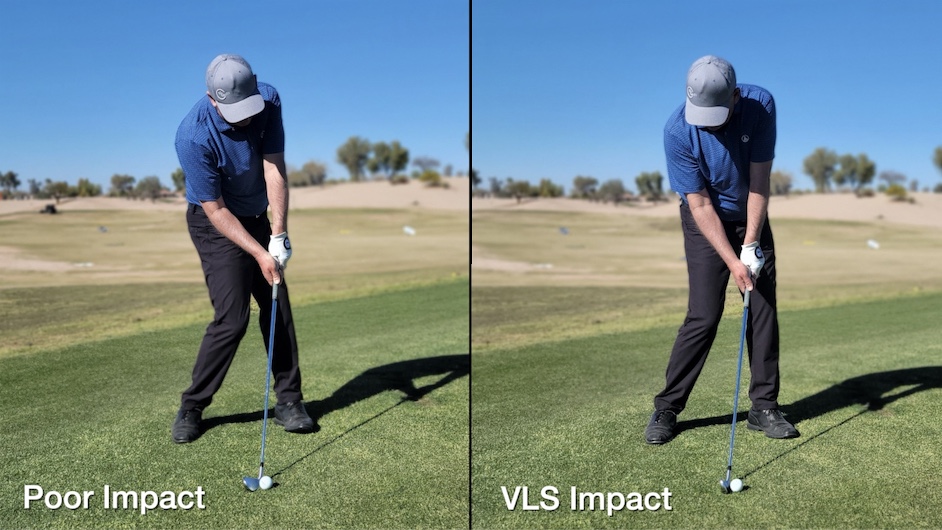
Now, simply reminding yourself to shift your weight forward on the downswing is one trick for how to stop hitting behind the golf ball. But if you want to make sure this idea sticks, you might as well get your body into the habit of doing it naturally.
Here’s a drill I use with my students:
Weight Shift Drill
- Take your regular setup.
- Step your lead foot back so it’s side-by-side with the trail foot.
- Take a practice swing, stepping the lead foot forward into its regular position as you swing down and through.
- Do a few practice swings just like that.
- Once you’ve got the feel for the weight shift, return to your regular stance and take a real shot.
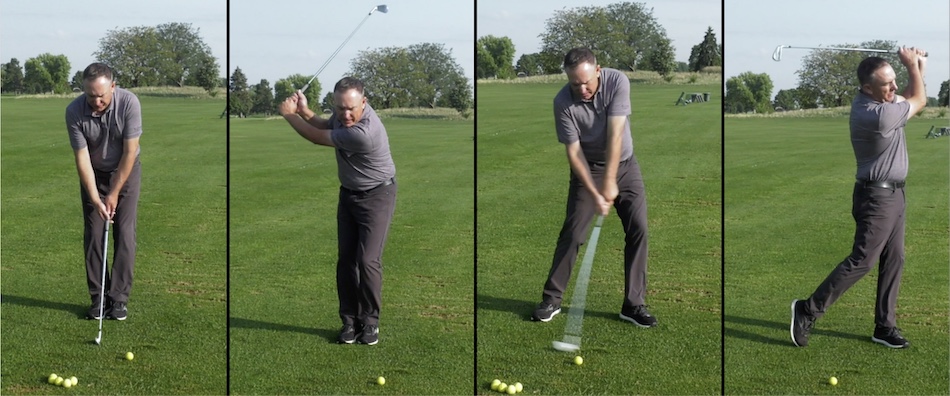
This drill should help you get in the habit of shifting your weight forward on the downswing.
Fix #2: Check Your Swing Direction
In what direction does your lead arm move on your backswing? Any chance you’re moving it low and to the inside?
A lot of golfers do, because it’s what they’re taught. You’ve likely been given the same advice—been told that you should swing low and around your body to generate more speed and get more distance.
Here’s the problem: we all reach a point when that advice doesn’t work so well anymore. That flat backswing might be the secret weapon for the young and flexible. But as we get older, we can’t rotate the way we used to.
Not only does swinging low and around shorten an “experienced” golfer’s swing, it also destroys their contact. It’s going to cause you to hit behind the ball.
So what’s the fix?
Let your lead arm move straight back and up on your backswing. When you do this, the club comes back down right where the ball is.
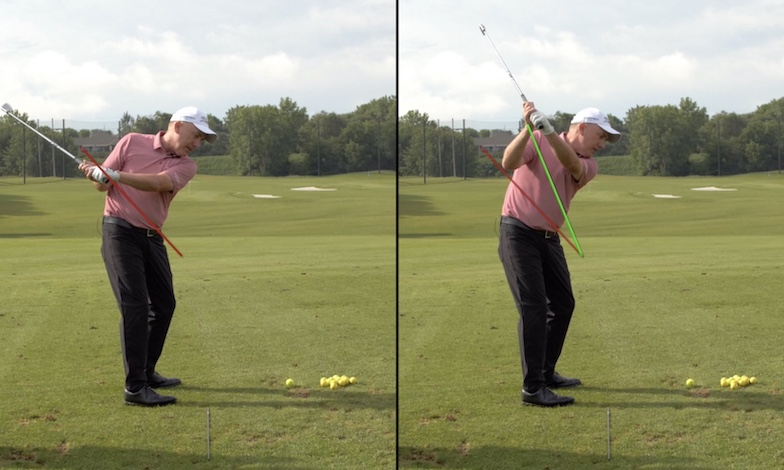
Bonus: because this vertical motion requires very little upper body turn, you can get a lot more length without the pain. And you know what more length in the backswing means, right? Better distance.
To be honest, I don’t really get why so little is said about the vertical backswing in golf. It’s a great option for golfers of all ages and it solves a multitude of problems.
I feel so strongly about this technique that I developed an entire coaching system around it. It’s called the Vertical Line Swing, and if you’ve seen a decline in your contact and distance over the years, I highly recommend checking it out.
Now, let’s say you’re already moving your lead arm back and up, and you’re already shifting your weight forward. What then?
I’ve got one more thing you can try, and it’s almost too simple to believe.
Fix #3: Check Your Ball Position
This has to be the easiest answer out there for how to stop hitting behind the golf ball. That might be why it’s also the most overlooked. It almost seems too easy to consider.
But trust me: a lot of golfers are out there making this mistake. So I’m asking you now:
Is the ball too far forward in your stance?
For iron shots, you want the ball a little forward of center. Line it up somewhere between the logo and the buttons on your golf shirt. When it’s in this position, you know you’ll hit the ball while the clubhead is still descending, just before or right at the low point of your swing.
If your ball is more forward, on the other hand, you’ll hit the low point of your swing before you make contact with the ball. You can expect either a crater-sized divot or another wormburner.
Now, if you could use some help finding the perfect ball position, here’s a technique I use with all my students:
- Stand with your feet together and the ball centered between them.
- Step your lead foot towards the target—let’s say about 5-6 inches depending on your height.
- Take a slightly larger step away from the target with your trail foot. If, for example, you stepped your lead foot 5 inches forward, step your trail foot about 6 inches back.
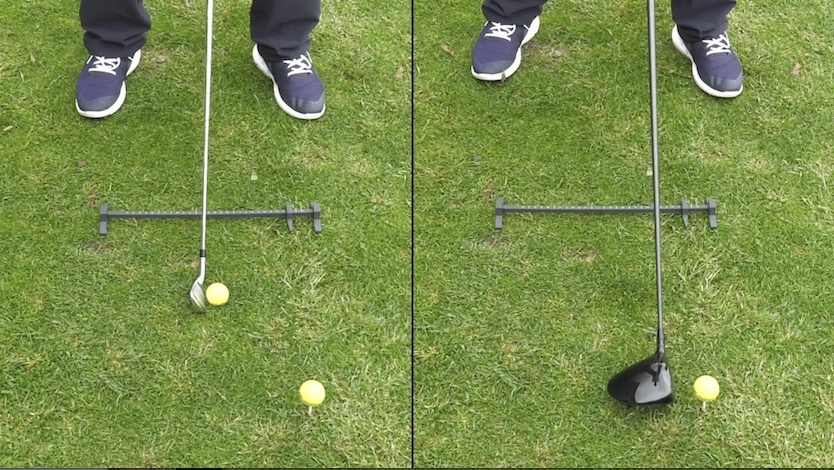
The exact size of each step you take will vary depending on the width of your specific golf stance. (I sometimes encourage older golfers to even widen their stance a bit if they struggle with balance.)
But you get the idea. One step forward. A slightly larger step back. And the ball ends up slightly forward of center for clean, solid contact.
Summing It Up: How to Stop Hitting Behind the Golf Ball
Here’s a quick checklist for the next time you head out to the golf course or driving range.
To stop hitting behind the golf ball, make sure:
- You shift your body weight forward as you swing down and through.
- The lead arm moves straight up and back on the backswing.
- The ball is positioned slightly forward of center, somewhere between the logo and buttons of your golf shirt.
Pretty easy adjustments, right? They may even seem too easy.
But give them a shot. I’ve seen these tricks put an end to topped shots and chili dips for countless golfers, and I’m confident they’ll do the same for you.
Let Me Know How It Goes!
Or let me know if you have any questions, want to share a difference of opinion, or want to see us cover something else here at USGolfTV.
I read your comments every day and we love hearing from you, so join the conversion below!
If you’re ready to take your game to the next level with customized coaching or one-on-one instruction, visit us at VLSCoaching.com. Or drop us an email at Info@VLSGolf.com and put COACHING in the subject line. We’ll get back to you right away.


Todd I am on day 5 of initiating the VLS swing for my game. Is it safe to assume that when I need to hit a straight shot rather than a draw, I can simply align my body and feet to the actual target line and make the same swing? Since I am not closed at address I assume that the club path would not be inside, and therefore a straighter ball flight. I can tell that the VLS system has made a tremendous difference in distance and contact , with so much less knee and back pain. I am 74 but it has been many years since my golf game has looked so good. Thanks, and continue the lessons they are so helpful, and can be implemented in a few trips to the range.
Great question and thanks for your support. The Vertical Line Swing is making a huge impact on the golf community. Yes, once you are hitting a nice high draw you can square up the stance from the slightly closed stance suggested in the program. Hope that helps.